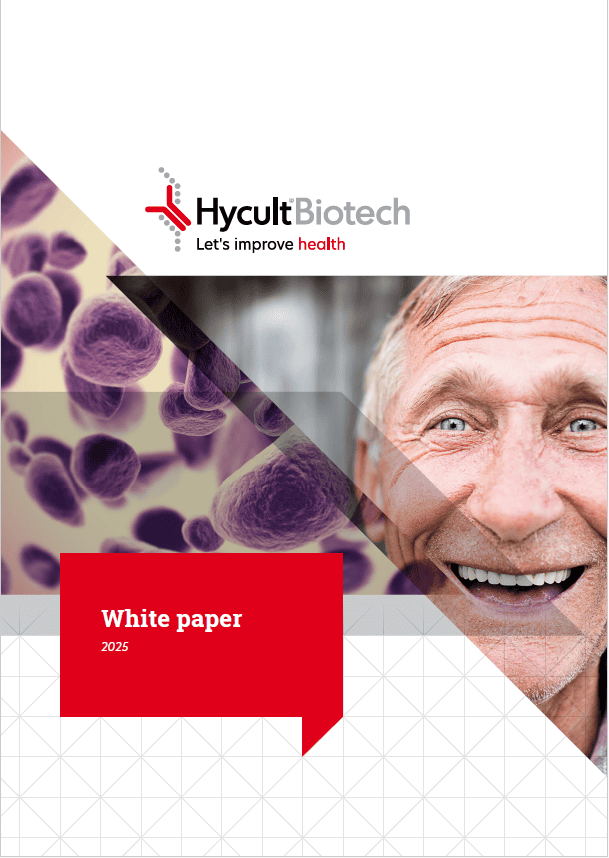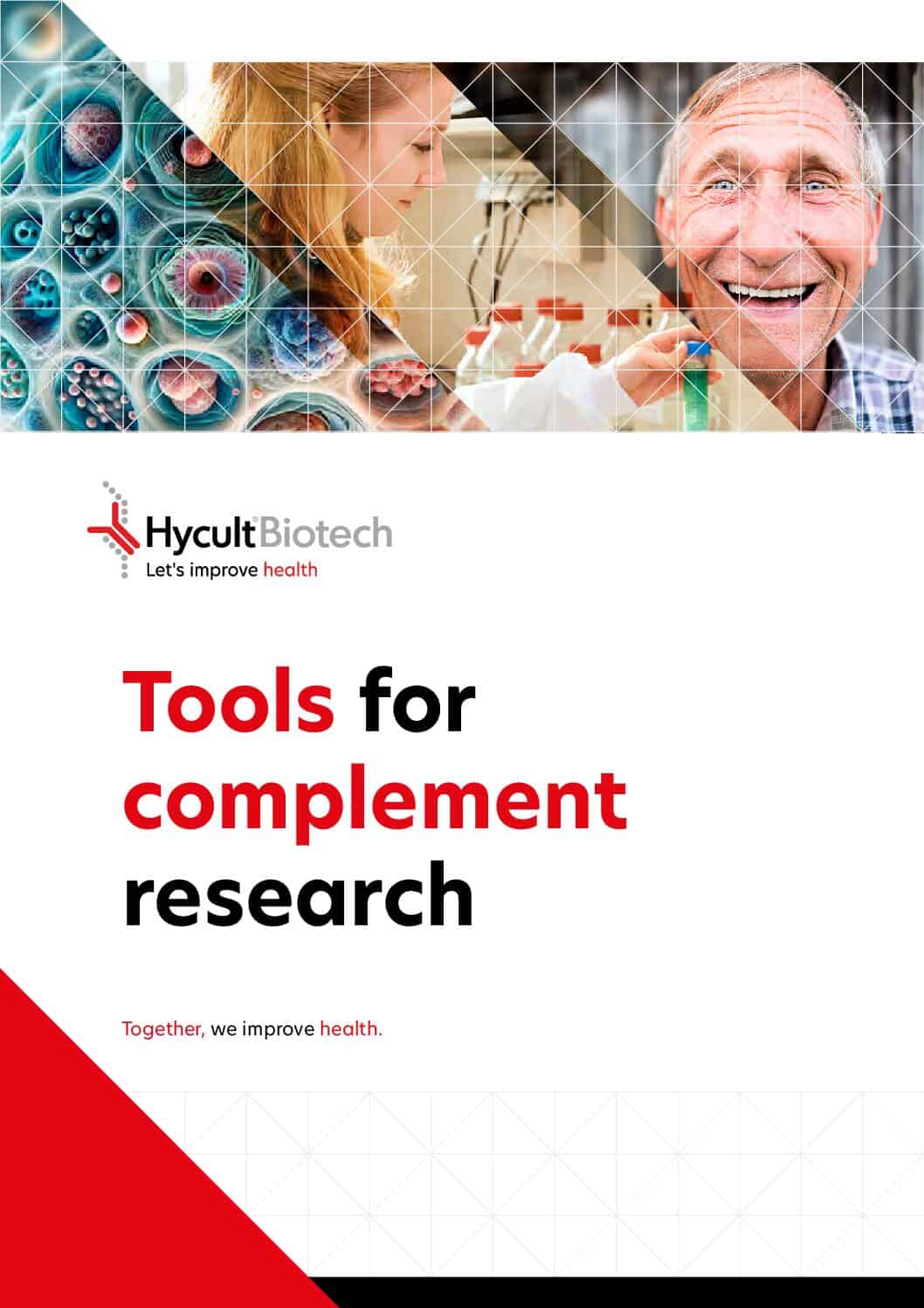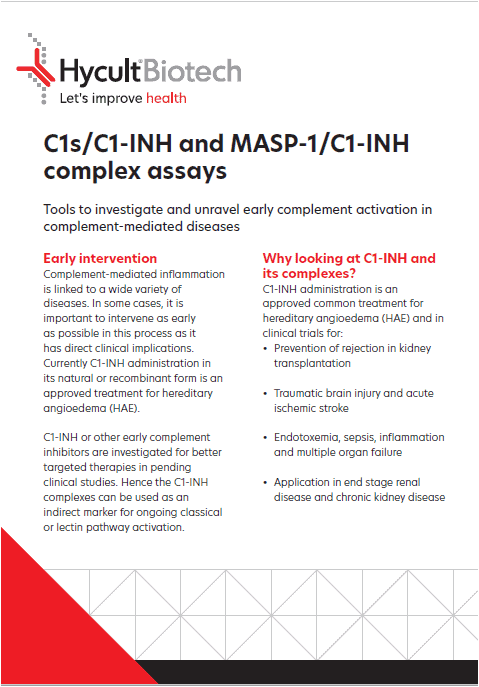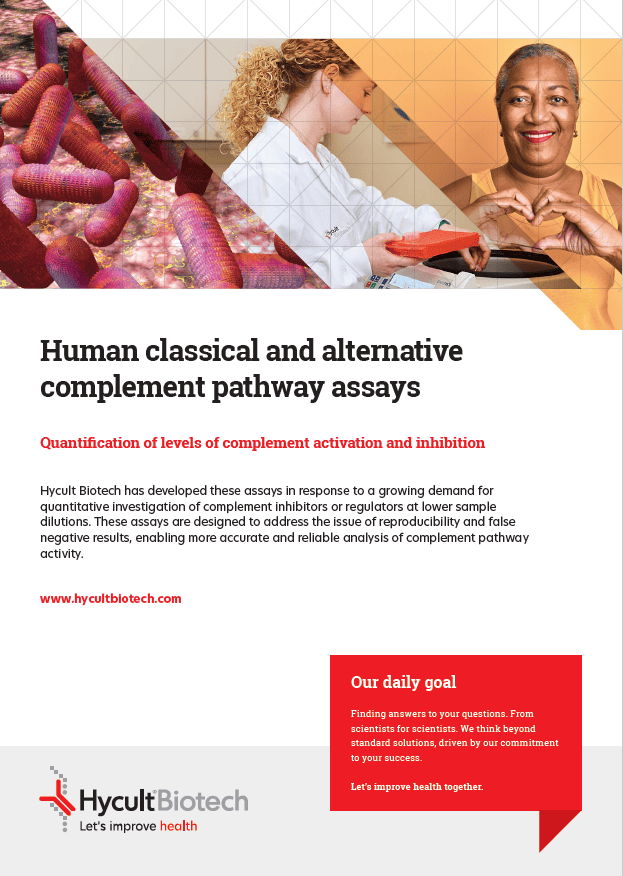Resources hub
This resources hub brings together everything you need to work with our products effectively. From protocols and procedures to troubleshooting guides and downloads. Whether you are setting up an ELISA or refining your Western blot, this is your starting point. We give you reliable tools and accessible knowledge.
On this page, you’ll find a complete set of resources to guide and support your immunology and complement research. Explore practical tools and materials including protocols, procedures, troubleshooting tips, calculation sheets, and informative folders and leaflets.
We are glad to support you!
Take advantage of our dedicated support team for any technical assistance you need while using our products or considering them for your research needs.
Guide to Complement Research
Explore our collection of expert resources designed to help you understand, analyze, and apply complement system research.
How to analyze

Accurate complement analysis requires proper analytical techniques and correct pre-analytical sample handling. To evaluate how this is applied in practice, our complement experts Erik Toonen and Ricardo Brandwijk conducted an extensive literature review of studies published between 2017 and 2022 that measured complement components in human blood.
Activation guide

Controlling the complement system is essential for studying immune responses and creating therapies for complement-related diseases. By using activators or inhibitors, researchers can either stimulate or suppress the system’s response. With tools like antibodies and ELISA kits, you can study and influence this system in detail.
C3 antibody guide

The complement system is an essential part of the immune system and C3 antibodies are crucial in immunological studies. Here you can find our comprehensive guide on choosing the perfect C3 antibody for your research. It is essential to select the right antibody to ensure the success of your research. This guide is designed to assist you in making an informed decision.
Application-specific resources
Each application has a dedicated section with detailed documentation. Select your technique to access protocols, procedures, and troubleshooting guides.

ELISA
Detailed instructions to set up, optimize, and troubleshoot ELISA assays.

SDS-PAGE
Instructions for gel preparation, electrophoresis, and resolving band issues.

Western Blotting
From transfer to detection comprehensive guidance for reproducible blots.
Calculate your ELISA data easily
With the ELISA calculator you can easily calculate ELISA data. Assayfit Pro helps to perform curve fitting. The calculator generates advanced reports, fit graph, fit parameters and goodness of fit are shown.
ELISA FAQ
Plotting a standard curve can be done using the linear-logarithmic method. We recommend using the Four Parameter Logistic (4PL) regression, which is suitable for creating a standard curve. The curve is constructed by plotting the mean absorbance for each standard on the vertical (Y) axis versis the corresponding concentration on the horizontal (X) axis.
For calculation of the results the straight part of the lin-log curve should be used as this part is the most reliable part of the curve. When the curve is not symmetrical a better fit will be achieved using a 5PL regression. An online resource for curve fitting can be found here Please verify if the software that comes with the ELISA plate reader is capable of performing linear regressions.
We do not recommend to mix components of two different lot numbers. Every batch is produced individually and components are optimized. Therefore, we cannot guarantee the results if components are mixed from different lots.
Please notice we test each batch for e.g. inter and intra-variation by two different operators with a lot-specific set of components and with samples with a known concentration. All of this is carried out to ensure that the variation between the different batches in minimized.
When we produce a new batch there may always be excess material avaible. However, these materials are usually limited. When a particular kit component from a particular lot is required, please contact our technical support to see if we are able to assist.
The sample types which are tested and supported by Hycult Biotech are mentioned in the manual. If you wish to test another sample type, please to not hesitate to contact our support team for more information.
If you wish to test a new sample type we recommend to run a recovery experiment. In this way, the influence of components in the sample on the detection of the protein can be determined. Add a known amount of standard into both diluted sample and dilution buffer. Run the samples in duplicate in the assay and calculate the recovery with regards to the normal sample.
The test is valid when the recovery percentage is within the range of 80-120%. If the recovery percentage falls outside this range the samples should be further diluted for a reliable detection of the protein.
The dilutions mentioned in the manual have been determined as a minimum dilution to prevent any matrix effect. Depending on the sample type, treatment of the sample or patient status a higher dilution might be required.
Use of a plate washer or automation may result in higher background and a decrease in sensitivity. We always advise to validate the plate washing method or automation by comparing it with the manual procedure.
We strongly recommend the use of polypropylene (PP) tubes. Polypropylene is a commonly used plastic in laboratory equipment as it has demonstrated to be durable and to have a minimal impact on biological activity. Use of other plastics is not recommended given that this may have an impact on the results.
Pathway assays FAQ
Yes, multiple quantification methodology can be applied.
For accurate quantification of complement activity it is advised to apply regression analysis on logistically transformed optical density (OD) values to determine the complement activity as percentage of the activity of the positive reference. This method can be found in following reference: Palarasah Y et al; Novel assays to assess the functional capacity of the classical, the alternative and the lectin pathways of the complement system. Clinical & Experimental Immunology 2011; 164: 388 (http://dx.doi.org/10.1111/j.1365-2249.2011.04322.x)
4PL is possible. Please note, the method is prone to errors and has lower accuracy. Slight differences in dilution factor can lead to large OD differences. Especially when just one or two dilutions are tested. For the standard curve, the obtained OD value should be plotted against the log activity of the reference standard (S1= 100%, S2=50%, S3=25%, S4=12.5%, S5=6.25%).
Semi-quantitative with your own reference sample, the complement activity can be calculated as follows:(OD sample – OD negative control) / (OD own reference sample – OD negative control) x 100%.
It is advised to base the result on a minimum of 3 dilutions.
If only 1 or 2 dilutions fit within the reference standard, we advise to retest the samples at adjusted dilutions.
It is well-known that complement activity levels in a healthy population is variable between individuals. Our reference sample is a pool of donors which are collected and processed with a dedicated protocol to ensure a fully complement preserved activity status. Therefore it is expected that our reference sample has a different activity status compared to a regular sample in the field. In other words this could lead to a different unit definition. As result the unit definition can differ from other pathway activation assays.


The assay has been designed in particular to test potential inhibitors or regulators on their activity. Most reliable results will be obtained when multiple concentrations of the inhibitor/regulator are tested against your own reference sample (see example figure).
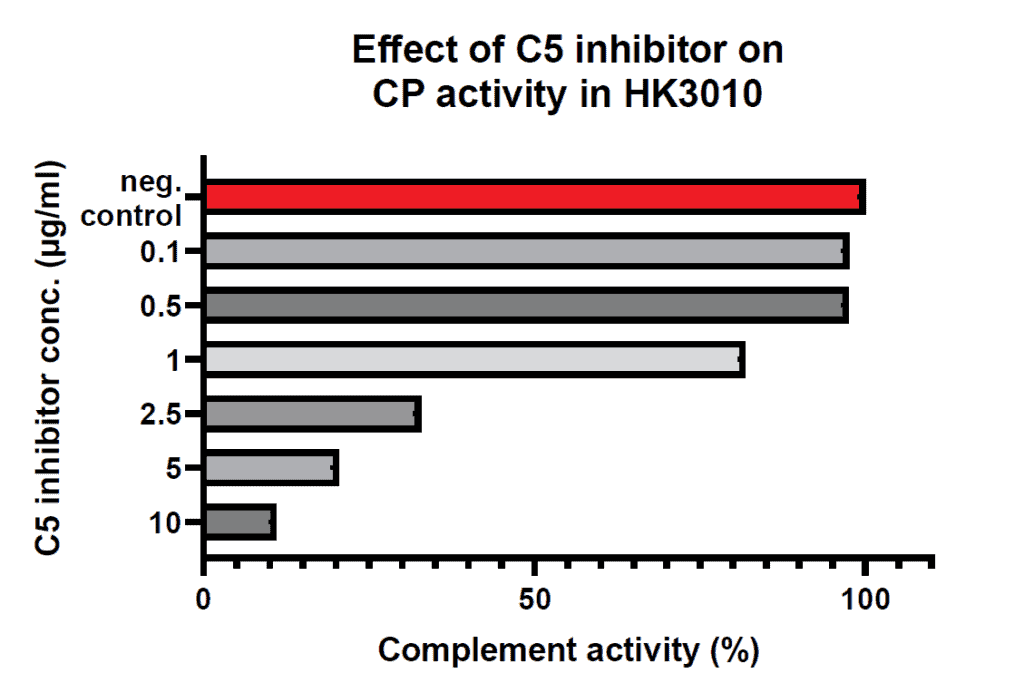
The complement pathway assays are optimal at incubation time indicated. Shortening the protocol is not advised, as this leads to a strong decrease in complement activity. Prolonging the incubation time leads to overactivation leading to too high OD values.
Whole blood samples might be useful, but have not been validated. Side effects could be expected. More insights on current guidelines for assessing complement activation can be found in the following paper: Brandwijk, R et al; Pitfalls in complement analysis: A systematic literature review of assessing complement activation. Front Immunol 2022; 13: 1007102.
Plasma samples cannot be used.
Preferably use fresh serum samples. Historical samples can also be used, the quality of the result might depend on handling and storage conditions. More insights on current guidelines for assessing complement activation can be found in the following paper: Brandwijk, R et al; Pitfalls in complement analysis: A systematic literature review of assessing complement activation. Front Immunol 2022; 13: 1007102.
By making use of pathway specific buffers and inhibitors we have blocked cross-interference of the other complement pathways. See figure below for an example of inhibition of the alternative pathway interference using INH01 in classical pathway assay (cat.# HK3010).

Both complement pathway assays (cat.# HK3010 and HK3012) have been validated on cynomolgus monkey serum samples. Measuring complement activity in cynomolgus monkey serum has to be optimized since the key-point dilution is at higher dilution compared to human serum samples. Please note that other NHP samples have not been tested, but are most likely useful because of expected high homology. If you are interested in using the assays for NHP and need custom adaption of protocol or assay format, custom services can be discussed. For that purpose, please contact us at support@hycultbiotech.com.
Antibody and protein FAQ
The immunogen (either sequence or material used) is sometimes either not known or confidential. In those cases the information on the immunogen is not available. If the information is known and not classified, we include this information in the CoA-TDS. If there is no information in this document, you can always check with the technical support team to verify if there is any information that we can share based on your particular situation.
If they are available, you can always find them on the product page of the unlabeled version under the section “You may also be interested in the following product(s)”. We have antibodies conjugated with biotin, FITC and R-PE. If a product is not available with a particular conjugate or label, we can perform a conjugation based on your research needs. Contact our support team to learn more about the possibilities and pricing of these services. Note that we start offering custom products starting from 1 mg onwards.
All critical production processes such as purification and filling take place under aseptic conditions. Even though we cannot claim complete sterility we strive for the highest standards when it comes to the prevention of contamination and sterility.
All antibodies that have a functional application are tested on endotoxins. If a product is tested on endotoxins, this exact concentration will be mentioned on the CoA-TDS when a product is purchased.
The optimal working dilution depends on the nature of the product or the detection system applied. It is recommended that users test the reagent and determine their own optimal dilutions. The typical starting working dilution is 1:50 for most of our antibodies.
Shipping and storage FAQ
If a product is shipped under ambient conditions this does not have any influence on the product. Once the products have been received we advise to store them under the recommended storage conditions. There are some exceptions as we do have some products (e.g. complement proteins) that are shipped using dry ice.
Hycult Biotech mainly works with FedEx as most shipments are dispatched using FedEx Express. Distributors may decide to work with other freight forwarders depending on preference, local circumstances or geographic conditions. Products are shipped under Ex Works conditions.
Hycult Biotech fully complies with international sanctions and trade regulations. If a country is sanctioned, we closely work with government authorities to ensure trade takes place in a legitimate way.

Did not find the answer you need?
Need extra guidance or can’t find the resource you’re looking for? Our support team is here to help you succeed in the lab.
